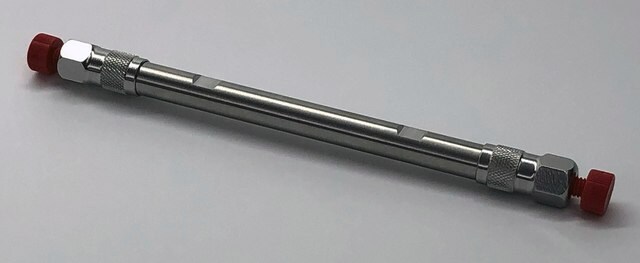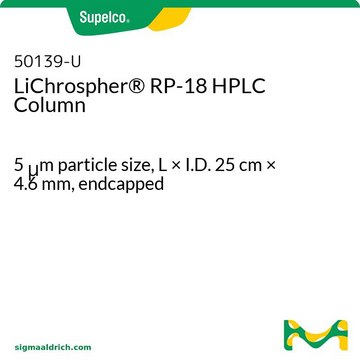53352-U
Ascentis® Express 90 Å Phenyl-Hexyl (2.7 μm) HPLC Columns
L × I.D. 10 cm × 4.6 mm, HPLC Column
Synonym(e):
Core-shell (SPP) Fused Core Phenyl HPLC column
About This Item
Empfohlene Produkte
product name
Ascentis® Express Phenyl-Hexyl, 2,7 μm HPLC-Säule, 2.7 μm particle size, L × I.D. 10 cm × 4.6 mm
Materialien
stainless steel column
Qualitätsniveau
Agentur
suitable for USP L11
Produktlinie
Ascentis®
Leistungsmerkmale
endcapped
Hersteller/Markenname
Ascentis®
Verpackung
1 ea of
Parameter
60 °C temp. range
600 bar max. pressure (9000 psi)
Methode(n)
HPLC: suitable
LC/MS: suitable
UHPLC-MS: suitable
UHPLC: suitable
L × ID
10 cm × 4.6 mm
Oberflächenbereich
135 m2/g
Verunreinigungen
<5 ppm metals
Matrix
Fused-Core particle platform
superficially porous particle
Aktive Matrixgruppe
phenylhexyl phase
Partikelgröße
2.7 μm
Porengröße
90 Å
pH-Bereich
2-9
Anwendung(en)
food and beverages
Trenntechnik
reversed phase
Suchen Sie nach ähnlichen Produkten? Aufrufen Leitfaden zum Produktvergleich
Verwandte Kategorien
Allgemeine Beschreibung
Anwendung
- A fully automated and fast method using direct sample injection combined with fused-core column on-line SPE-HPLC for determination of ochratoxin A and citrinin in lager beers: Demonstrates the robustness of the Ascentis® Express Phenyl-Hexyl, 2.7 μm HPLC column in automating the detection of contaminants in beverages. This study showcases the column′s capacity for high throughput analysis, essential for quality control in the food industry, ensuring safety and compliance with regulatory standards (Lhotská et al., 2016).
- Advantages of core-shell particle columns in Sequential Injection Chromatography for determination of phenolic acids: This research highlights the efficiency of the Ascentis® Express Phenyl-Hexyl column in analyzing complex phenolic compounds, illustrating its superior performance in environmental and pharmaceutical applications. The column′s design enables enhanced separation capabilities, crucial for accurate phenolic profiling in various samples (Chocholouš et al., 2013).
Rechtliche Hinweise
Erforderlich, aber nicht bereitgestellt
Vorsäulenkartusche
Ähnliches Produkt
Lagerklassenschlüssel
11 - Combustible Solids
WGK
WGK 3
Flammpunkt (°F)
Not applicable
Flammpunkt (°C)
Not applicable
Hier finden Sie alle aktuellen Versionen:
Analysenzertifikate (COA)
Die passende Version wird nicht angezeigt?
Wenn Sie eine bestimmte Version benötigen, können Sie anhand der Lot- oder Chargennummer nach einem spezifischen Zertifikat suchen.
Besitzen Sie dieses Produkt bereits?
In der Dokumentenbibliothek finden Sie die Dokumentation zu den Produkten, die Sie kürzlich erworben haben.
Artikel
Improve your reversed phase selectivity for polar aromatics and heterocyclic compounds with the Ascentis® Express Phenyl-Hexyl U/HPLC column.
Protokolle
RP-Amide and HILIC, both amenable to the analysis of polar compounds, were successfully used to resolve several beverage components, including sugars, vitamins, sweeteners, preservatives, and caffeine.
Unser Team von Wissenschaftlern verfügt über Erfahrung in allen Forschungsbereichen einschließlich Life Science, Materialwissenschaften, chemischer Synthese, Chromatographie, Analytik und vielen mehr..
Setzen Sie sich mit dem technischen Dienst in Verbindung.




